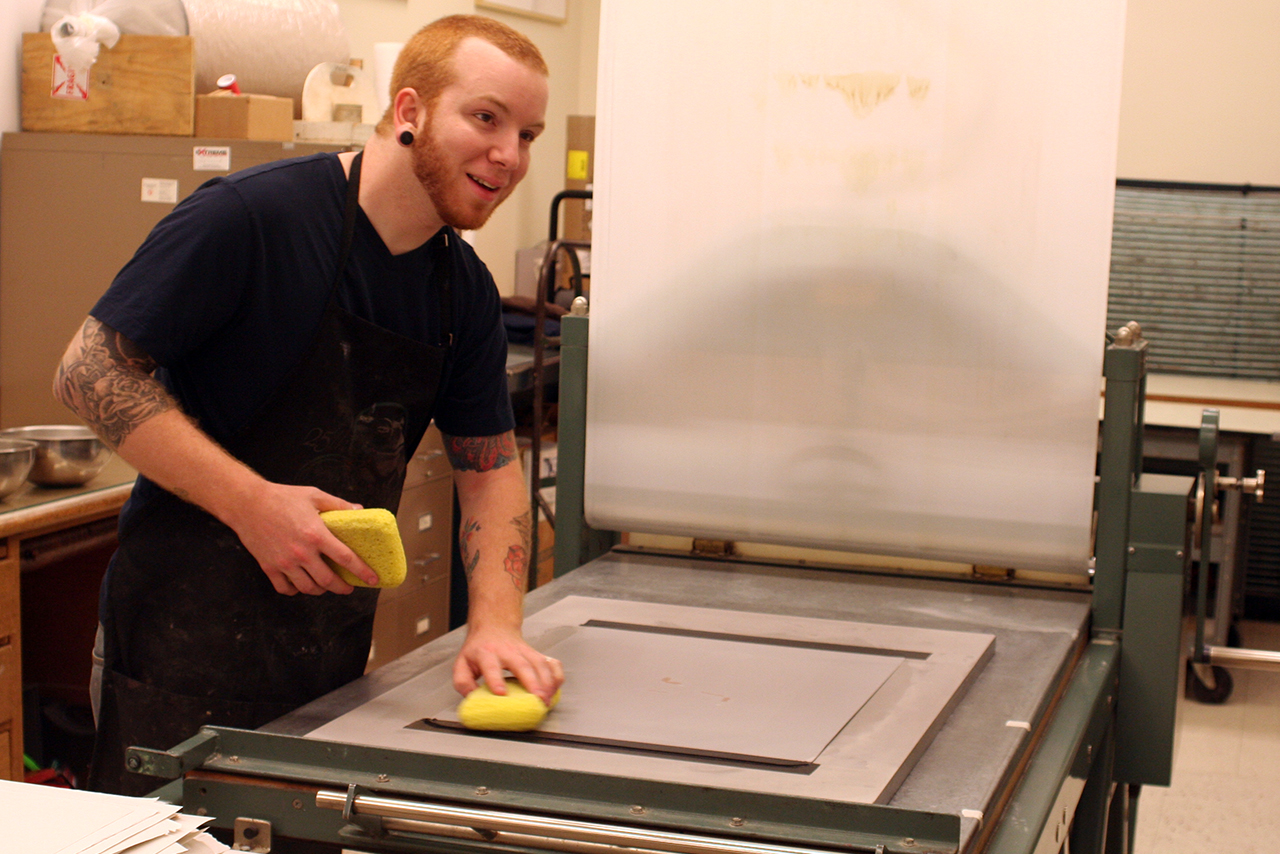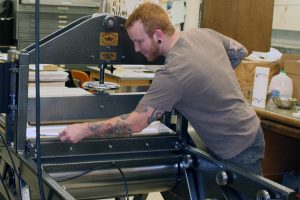Recently Professor Sarah Smelser sat down with Nick Satinover, M.F.A. ’10, to discuss his experiences at Normal Editions and how they prepared him for his career as an artist-educator.
SS: Tell me a little bit about yourself. Where are you from? What brought you to Illinois State University? “Everyone at Illinois State University seemed genuinely interested in finding graduates who would succeed in their program and funding them.”
NS: My name is Nick Satinover and I am currently an associate professor of print media at Middle Tennessee State University in Murfreesboro, Tennessee. I am the proud father of twin boys, August and Desmond, and partner to Brittany Satinover. Beyond making prints, teaching, and parenting, I enjoy good coffee and running. I was born in Scottsdale, Arizona, but ultimately grew up in and call Dayton, Ohio, home. It is a place I am proud to be from and my reverie for it has grown over the years.
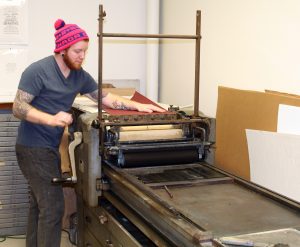
Nick Satinover working the Vandercook letterpress printing covers for the CVA Suite Vol. III project, February 2009
When I began the process of researching graduate school, I had a vague notion that we (Brittany and I) wanted to be nearer to Chicago. As a Midwesterner, that seemed like the ultimate destination and thus I applied to a variety of programs within the state of Illinois. Illinois State University landed at the top of my list because of faculty recommendations from my (undergraduate) mentors at Wright State University. When applications started coming back, Jim Butler called me and spent some time talking with me on the phone. No other schools did that. Soon after I was invited to visit and told not to make a decision until I came, met everyone and learned about the program. No other schools did that either.
When I visited everyone spent time talking and looking at my work, asking me some questions and making sure I understood the structure and expectations of the program. It made a huge impression upon me. Everyone at Illinois State University seemed genuinely interested in finding graduates who would succeed in their program and funding them. I found that reassuring and it made me feel that their invitation to attend was far more personal and considerate than many other places that made offers.
SS: What sorts of things did you do in Normal Editions? What did you learn there?
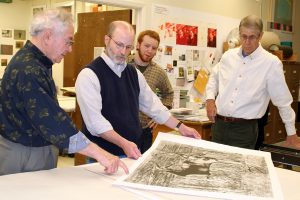
Rudy Pozzatti, Richard Finch, Nick Satinover, and Jim Butler review trial proofs during an initial visit of the artist to Normal Editions for the Twelve Labors of Hercules series, May 2009
NS: During my first year at Illinois State, Normal Editions celebrated its 30th anniversary, so immediately I think I was put to work in support of the Frontiers conference. Those day to day tasks might have included preparing materials for exchange portfolios or exhibitions or working on mailing materials. In my second and third year, I got a lot more hands-on printing experience at Normal Editions. I sponged for several of the editions created with Rudy Pozzatti—a significant highlight of my time there. I prepared paper and interleaving for other projects, got to observe the completion/signing of some things which predated my time at Illinois State University, cleaned work in frames and prepared it for shipping.
I learned quite a bit of technical information about lithography—of course—but also many “best practices” for dealing with prints, working with visitors, maintaining archives and daily operations of a non-profit. I recall lots of work going into annual grant applications, which was my first experience with that sort of thing—something which still intimidates me.
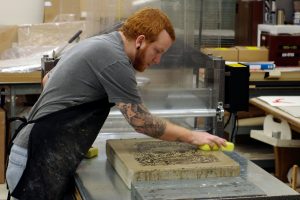
Nick Satinover sponging the lithographic stone during edition printing of the collaborative project with artist Hector Duarte, September 2008
I felt valued as a part of the team—even while doing tasks which may not have been glamorous—I was always made to feel that they were important and valued. I think that this is very important. Much of the daily operation of a print studio is repetitive and/or purely functional. For example, trimming newsprint to size to back a sheet of good paper so it is easier to handle is not an exotic task. However, it contributes to the success of a project and eases the collaboration. Learning to appreciate and value those tasks has allowed me to develop personal studio strategies which support prolonged projects in more successful ways.
SS: How have you carried your experiences in Normal Editions into your studio practice and teaching life?
“The structure and value of all components which contribute to making a print project have been carried forth from Normal Editions to my current work/studio life.”
NS: Working with Normal Editions provided me a wonderful template for collaborating with visiting artists, which I’ve done at three institutions since graduating. While teaching at the University of Minnesota I began an initiative to produce print editions for departmental colleagues, something I copied from the CVA suites Normal Editions produced over the years. While I relocated before seeing it past one visitor, I have taken the log procedure, proofing and documentation binder to Middle Tennessee State University where I employ it with visitors currently. That initiative, like Normal Editions, involved students in support roles for producing prints.
The color trial proofing process has become something I require students to do within several of their projects in the classes I teach. By making several options, they make comparable examples, and we can have deeper and more informed conversations about how color and layering work with their images to build more compelling images. It also re-enforces printing procedures like set up, color mixing, paper prep, execution and clean up, all of which builds more confidence and skill through repetition.

Nick Satinover and Jim Butler pull a freshly printed impression of Jim’s drawing from a lithographic stone at Normal Editions, May 2009
In my own practice, which is primarily rooted (at least in printing) in lithography, I utilize much of the knowledge gained from working on projects with Richard Finch and Veda Rives Aukerman. Everything I know about mixing/controlling ink, rolling, photo plates, editioning lithographs, I learned from my time at Normal Editions (as well as assisting for Jim Butler). I cannot overstate how valuable all that information and training has been. It allowed me to build the portfolio of work which gained me admittance to several residencies and secured me my teaching position.
The structure and value of all components which contribute to making a print project have been carried forth from Normal Editions to my current work/studio life.
